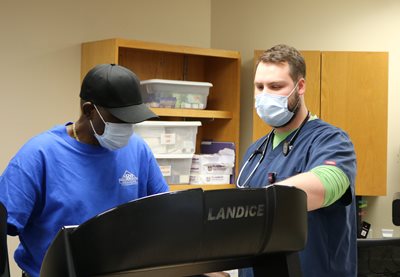 When Walumba Katanga arrived at the CMC Emergency Department, he had already been diagnosed with pneumonia and had just tested positive for COVID-19. That was May 2nd, 2020. The next thing he remembers, it was month later and he was in the Intensitve Care Unit.
When Walumba Katanga arrived at the CMC Emergency Department, he had already been diagnosed with pneumonia and had just tested positive for COVID-19. That was May 2nd, 2020. The next thing he remembers, it was month later and he was in the Intensitve Care Unit.
“I woke up and all of my body was weak—my legs, my head, my mouth. I had a catheter for dialysis, I couldn’t move my legs, and I was hungry.” Waking up was the first step in a long recovery for the 59-year-old. Katanga was eventually moved to a step-down unit and learned how to eat again. On July 10th, he was discharged to a rehabilitation hospital where he regained full use of his kidneys–something he was told might not happen. He went home on July 29th where he started physical, occupational and speech therapy.
But by Thanksgiving he had a setback and was hospitalized for severely high blood pressure. In addition to that, he continued to struggle with shortness of breath, needed an oxygen tank, and used a cane to walk. He was referred to CMC’s Pulmonary Fitness Program.
“When Walumba came to us he had a pronounced physical limp,” recalls CMC Exercise Specialist Argus Murphy. “He had to pick up his leg every time he was going to use it. He rarely does that now.”
Pulmonary fitness helps patients with chronic pulmonary conditions build strength and endurance.
These days, “we’re seeing a lot of post COVID patients, especially the ones who were very sick,” says Lorna Marshall, the Pulmonary Fitness Program supervisor. “They’ve done very well. Walumba was the extreme. He went from his body completely shutting down to now talking about going back to work.”
Shortness of breath and weakness are common long-term effects of COVID-19. They’re also symptoms that are exceptionally difficult for people who never experienced lung problems before COVID-19.
“When you become short of breath you become anxious,” explains Marshall. “That anxiety keeps you from being active and doing every day things. Teaching patients techniques like pursed lip breathing and how to use their diaphragm empowers them to take control of their breathing and remain calm.”
The Pulmonary Fitness Program meets twice a week for an hour at a time. Patients are also provided online educational modules that cover topics like nutrition, hand hygiene and adaptive equipment.
Katanga made tremendous gains in the eight-week program.
“The first day I had him do ten minutes on the elliptical at a low level,” recalls Murphy. “Now he’s doing 35 minutes at a much higher intensity. He’s the strongest person I’ve had in resistance training.”
He’s abandoned the cane, too. “With Argus’ help, I started to walk on my right leg,” says Katanga. “When I came home (from the hospital) I went through 15 oxygen tanks. Now, no more. I feel stronger now.”
Learn more about our: Pulmonary Rehab Program